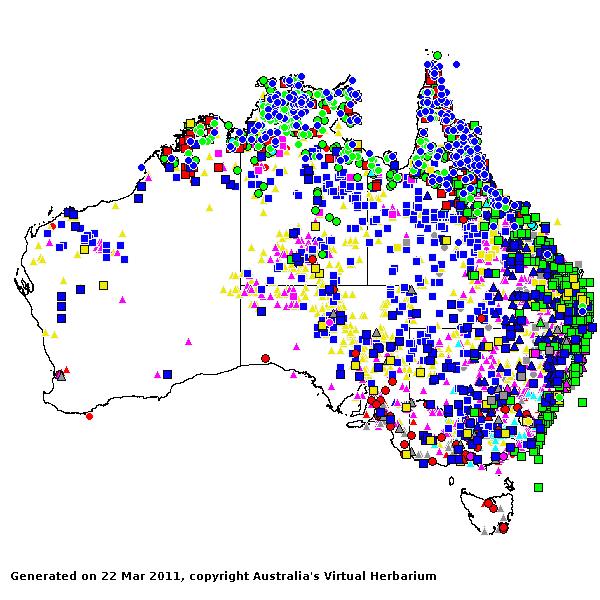Panicum Sp. Pl .55 (1753).
Derivation:. Old Latin name for common millet, Setaria italica, from Latin panis (bread).
Taxonomic revisions, nomenclatural references:. B.K.Simon, Austrobaileya 3: 594–598 (1992).
Key references (keys and floras):. G.Bentham, Flora Australiensis 7: 463–491 (incl. Digitaria, Echinochloa) (1878); C.A.Gardner, Flora of Western Australia 1 Gramineae 254–260 (1952); E.E.Henty, Manual Grasses New Guinea 140–144 (1969); J.W.Vickery, Flora of New South Wales, Gramineae 19: 137–138 (1975); M.Lazarides, Tropical Grasses S.E.Asia 126–130 (1980); M.Lazarides, Flora of Central Australia 471–472 (1981); J.C.Tothill and J.B.Hacker, Grasses of Southern Queensland 320–323 (1983); J.P.Jessop, Flora of South Australia 4: 1968–1970(1986); R.D.Webster, Australian Paniceae 118–146 (1987); T.D.Macfarlane, Flora of the Kimberley Region 1195–1196, 1198–1199 (1992); B.K.Simon, Key to Australian Grasses 135–138 (1993); S.W.L.Jacobs and C.A.Wall, Flora of New South Wales 4: 482–489(1993); N.G.Walsh, Flora of Victoria 2: 582–590 (1994); D.I.Morris, Student's Flora of Tasmania 4B: 333–335 (1994); E.Edgar and H.E.Connor, Flora of New Zealand 5: 557–564 (2000); D.Sharp and B.K.Simon, AusGrass (2002); J.P.Jessop, Grasses of South Australia 456–465 (2006); S.W.L.Jacobs, R.D.B.Whalley & D.J.B.Wheeler, Grasses of New South Wales, 4th ed, 312–319 (2008).
W.D.Clayton & S.A.Renvoize, Genera Graminum (1986), genus (455).
Native and naturalised. About 370 species, from tropical, subtropical and warm temperate regions. 35 species in Australia, WA, NT, SA, Qld, NSW, Vic, and Tas. Also New Guinea, Malesia and New Zealand.
Habit. Annual or perennial, rhizomatous or stoloniferous or tufted or decumbent. Culms woody and persistent, or herbaceous. Leaf blades broad or narrow, cordate or not cordate. Ligule an unfringed membrane or a fringed membrane to a fringe of hairs.
Inflorescence. Inflorescence paniculate, an open panicle with branches ending in single spikelets, open or contracted.
Spikelets. Spikelets dorsally compressed, 2 flowered, with 1 fertile floret, solitary, pedicelled. Fertile spikelets with lower incomplete floret(s), elliptic or lanceolate or ovate or obovate, adaxial (with lower glume against rachis) (in the few cases where the orientation is ascertainable), dorsally compressed, falling with glumes or not disarticulating, with conventional internode spacings or with a distinctly elongated rachilla internode between glumes or with distinctly elongated rachilla internodes between florets or with a distinctly elongated rachilla internode between glumes and with distinctly elongated rachilla internodes between florets. Upper floret borne on a swollen stipe, or upper floret not stipitate. Stipe beneath upper floret when present, not filiform, straight and swollen, heterogeneous or homogeneous.
Glumes. Glumes nearly always unequal, (the longer) long relative to adjacent lemmas, nearly always awnless (the upper glume truncate to pointed, very rarely shortly awn-tipped), dissimilar or similar (herbaceous-membranous, the lower sometimes very short and nerveless). Lower glume 1–7 nerved. Upper glume 3–9 nerved.
Florets. Lower incomplete floret(s) male, or sterile. Lemmas awnless, 3 nerved (rarely) or 5–9 nerved or 11 nerved (rarely), more or less equalling fertile lemmas to exceeding fertile lemmas, less firm than fertile lemmas, not becoming indurated. Fertile florets 1. Lemmas similar in texture to glumes to decidedly firmer than glumes, smooth, becoming indurated to not becoming indurated (leathery, bony or cartilaginous), yellow in fruit or brown in fruit, entire at apex, pointed or blunt, usually not crested, muticous (rarely minutely apiculate), with a clear germination flap, 3–11 nerved, glabrous, having margins tucked into palea. Palea relatively long, tightly clasped by lemma, entire, textured like lemma, indurated or not indurated, 2 nerved. Lodicules 2. Stamens 3. Grain small, compressed dorsiventrally. Hilum short. Embryo large.
Kranz Anatomy. C4 or C3, biochemical type PCK (5 species) or NAD-ME (14 species) or NADP-ME (4 species).
2n = 18 (seemingly rarely) or 36 or 37 or 54 or 72, commonly adventive.
Habitat. Mesophytic, xerophytic. Diverse habitats. Shade species and species of open habitats.
Classification. Panicoideae; Paniceae.
Notes. The genus lies at the heart of a sprawling complex of interrelated neighbours. Some of these are minor satellites, dependent upon a subjective judgement as to whether they warrant recognition at generic level; this judgement has, perhaps, been exercised more critically in the Old World than the New. Others are certainly of generic status but their circumscription is complicated by the presence of intermediate species linking them to Panicum (Clayton and Renvoize, 1986). It is obvious that Panicum is a polyphyletic genus, and should be divided into several taxa (Zuloaga, Morrone and Giussani, 2000).
Types Species. P. miliaceum L.
Biogeographic Element. Clifford & Simon 1981, Simon & Jacobs 1990: Gondwanan.


